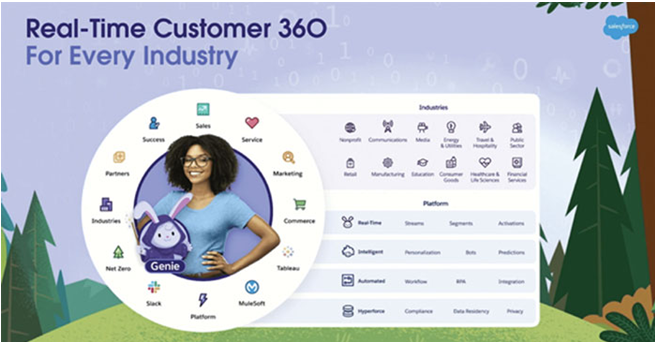On the right-hand side of the diagram, we can see the Marketing Cloud products. Marketing cloud products are connected with the core Salesforce platform using the Marketing Cloud connector.
- Marketing Cloud Intelligence (formerly known as Datorama): For holistic reporting from all the marketing channels
- Marketing Cloud Personalization (formerly Interaction studio): helps to create personalized experiences for customers
- Marketing Cloud Advertising (formerly Advertising studio): provides access to different advertising platforms like Instagram, Facebook, Twitter Google, and so on, from the Salesforce platform.
- Journey Builder: helps to build powerful marketing journeys
- Email Studio: For email marketing
- Mobile Studio: For mobile marketing
- Marketing Cloud Customer Data Platform (formerly Salesforce CDP): for unifying customer data
Marketing Cloud Account Engagement (formerly known as Pardot)
It is used for B2B email marketing, landing page generation, lead generation, and so on, available through Pardot connector.
Tableau
It is used for analytics using the data stored in the Salesforce database as well as in the external database.
Commerce Cloud
It is used for creating B2C and B2B digital storefronts for e-commerce. It provides all the functionalities that are required to build an e-commerce store. It is available through the Commerce Cloud connector.
Salesforce Data Cloud Customer Data Cloud
So where does Salesforce Data Cloud customer data cloud fit in? For the purpose of this book, we will call Salesforce Data Cloud Customer Data Cloud as Salesforce Data Cloud. Salesforce Data Cloud is a relatively new addition to the Salesforce product portfolio. Salesforce Data Cloud is an active common layer across the core applications as well as other Salesforce products, which will help to bring in data from different Salesforce products as well as from external systems into a single repository. This helps to create a 360-degree view of the customer. Salesforce CDP did the same thing earlier. But Salesforce Data Cloud can do it at scale and on a real-time basis. Customer data is continuously updated with new data from any of the Salesforce products and then fed into the repository. Your data remains fresh all the time. This helps make Salesforce an integrated CRM platform.
To visualize Salesforce Data Cloud as part of the Salesforce product portfolio, we need to look at the following diagram:

Figure 1.6: Salesforce Data Cloud connects all Salesforce and other third-party applications together through a common data repository (source- https://www.v2sa.com/salesforce-Data-Cloud-and-marketing-clouds-customer-data-platform/#:~:text=Where%20does%20Data-Cloud%20fit%20in,can%20differentiate%20within%20an%20organization. )
Salesforce Data Cloud takes a central position among the Salesforce products wherein it connects all the different Salesforce applications and other third-party applications together. It brings the data from different applications, whether they are from Salesforce or from other third-party applications, and provides common storage for this data. The data then can be unified and sent to different applications for solving business use cases.
We will discuss more on Salesforce Data Cloud in the later chapters. For now, it is enough to understand that Salesforce Data Cloud helps to bring real-time data from different systems and enables Salesforce to provide a 360-degree view of the customer.

